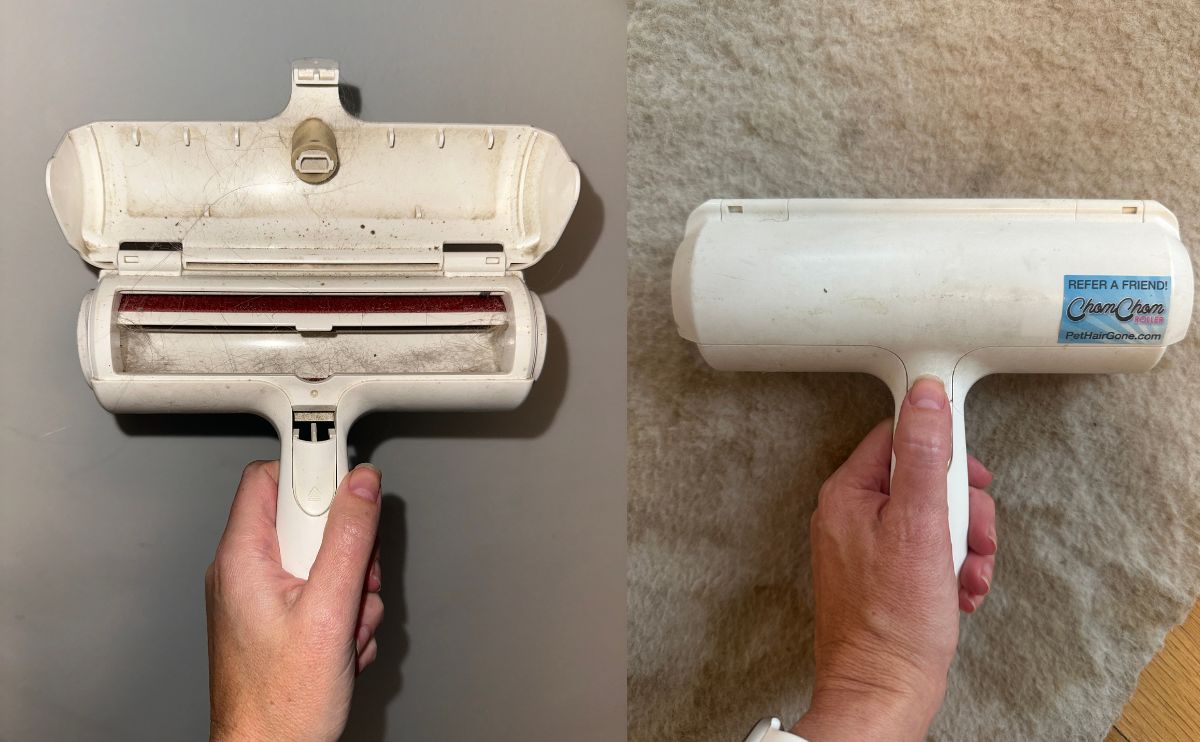To keep the lights on, we receive affiliate commissions via some of our links. Our review process.
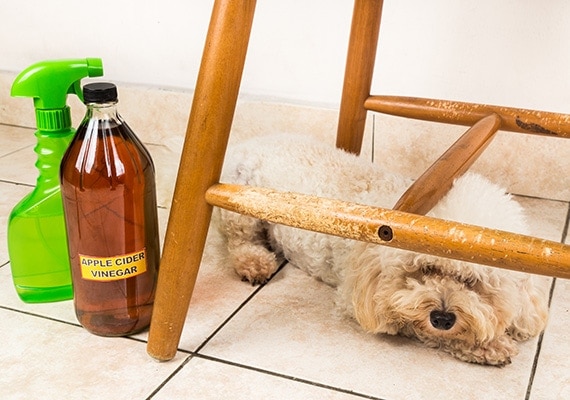
So, you have a new pup that shreds anything he can sink his teeth into? Or maybe your dog won’t stop biting his fur?
An anti-chew spray may be the perfect solution!
This foul-tasting spray can stop your dog in his tracks, turning a troublesome chewer into a well-behaved pooch.
We spent 80+ hours reviewing over 15 different anti-chew sprays. Here are just a few of the ones we tested…

All told, with the help of over 100 dogs, we reviewed the spray’s success rate, ingredients and how long each one lasted. All to answer a single question:
Which anti-chew spray is best?
Want the answer? Then read on!
What is an anti-chew spray?

A bottle of anti-chew spray contains a bad-tasting but harmless liquid. Use this spray to discourage your dog from chewing or licking things he shouldn’t, such as drywall, furniture or electrical wires.
You might also hear anti-chew sprays referred to as a no-bite spray or dog deterrent or even bitter apple spray. Whatever you call it, it’s the same thing.
The exact formula of an anti-chew spray varies from brand to brand. Most commonly, a bitter ingredient is used, such as grapefruit skins.
It’s the bitter ingredients that deter your dog…
If you have ever seen a dog suck on a lemon (It’s hilarious!), you know how much they hate the sour taste. Anti-chew sprays are even more sour than a lemon.

Dogs taste whatever it is they are chewing on. When they get a lick of the bitter chew spray, they immediately give up.
While it may look like your dog is suffering, it’s completely harmless.
Allow me to show you how it works.
Here is Norris, chewing on my daughter’s toy. He has his own plush dog toys and this one is off-limits…
But he loves this toy so much that he can’t resist and will sneak off with it if I am not around.

A light mist from the anti-chew spray bottle…

The next time he tried to grab the toy he was rewarded with a foul taste.
I don’t have to tell you that Norris didn’t like it. In fact, he made this face for a good 2 minutes!

Norris is a smart dog. He decided one taste was enough. Now he won’t go near the plush toy or the spray bottle.

Success! Norris no longer seeks out this toy to play with when I’m not around.
It’s important to note that an anti-chew spray isn’t a dog repellent. A dog repellent keeps your dog away from specific areas in your home – often by using chili powder. Your dog will still go near an anti-chew spray, he just won’t bite it.
Oh, and it goes without saying that your dog needs to sniff and lick the anti-chew spray for it to be effective. Your dog must taste the sour spray before deciding it’s not worth the effort.
Does your dog need an anti-chew spray?
If your dog is a destructive chewer, then a bottle of anti-chew spray could stop him in his tracks.
But don’t rush out and buy a bottle of anti-chew spray just yet.
You didn’t think it would be that easy, did you?
First, you need to determine why your dog is chewing things you don’t want him to.[1]
You see… Anti-chew sprays may stop your dog from chewing, but they don’t solve the cause. This means the moment you stop using an anti-chew spray, your dog will return to his chewing ways.
If you want the best results from an anti-chew spray, then it should be used in addition to correcting the destructive behavior.
Let me show you three examples to explain what I mean…
1. A new puppy
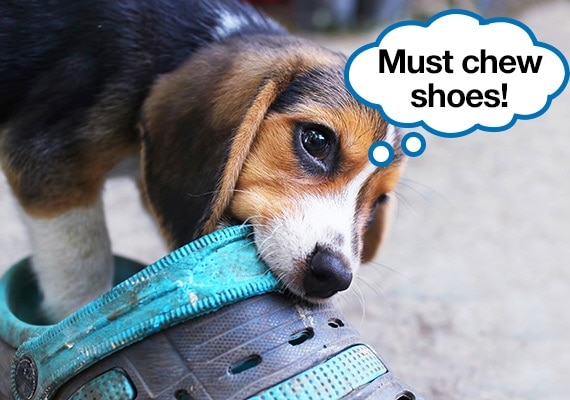
Puppies explore and learn by biting. They also chew to ease the discomfort of their developing teeth. This means everything in your home is fair game – from crate bedding and shoes to furniture legs and electrical cords![2]
The solution:
Place chewables like shoes out of reach, and introduce your pup to a range of toys he can chew on. Train your puppy that chewing on anything else is unwanted behavior. Further discourage him by using an anti-chew spray on chewable objects that can’t be moved.
2. Boredom

A bored dog will look for a way to entertain himself. Unfortunately, that may include chewing on your baseboards or couch.[3]
The solution:
Provide your dog with a range of toys, and train your pup that chewing on anything else is off-limits. Use an anti-chew spray on whatever he shows an interest in.
3. Separation anxiety
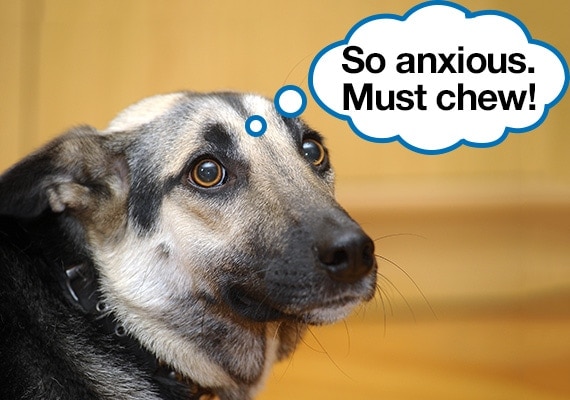
If your dog is left home alone, he might become anxious when you leave. Many dogs chew to relieve this anxiety.[4]
The solution:
Training is necessary to get your dog used to time alone. While making the transition, spray commonly chewed areas with an anti-chew spray.
As you see, an anti-chew spray works best while also treating the destructive behavior. Think of an anti-chew spray as a training aid – one that helps your dog know what he can’t chew on.
Solely relying on an anti-chew spray rarely curbs the destructive behavior. You are just slapping a band-aid on a problem that needs addressing. The moment you stop using the spray, the same behavior will start again.
Even so, the best anti-chew sprays are more than capable of preventing a determined dog from chewing on things he shouldn’t. Which brings me to my next point…
Do anti-chew sprays even work?

Yes, but you need to find the right anti-chew spray for your dog.
You see, choosing the best no-chew spray for your dog is a game of chance. What works for one dog might not necessarily work for another.
As we quickly learned, different dogs have different tastes. One dog may find a particular anti-chew spray disgusting, but another might think it’s the tastiest thing he’s ever licked.
Even those of the same breed…
Bolt, a Rottweiler, wouldn’t go near a particular anti-chew spray made from bitter apple – it even prevented him from chewing on his favorite chew toy.
Duke, another Rottweiler, couldn’t get enough of it. He wouldn’t stop licking anything we coated it in. It’s like he thought it was a treat.
Depending on your pup’s taste buds, you may need to test a few different anti-chew sprays before finding the right one. Unfortunately, this makes choosing the ideal chew spray for your dog a lesson in trial and error.
DogLab Tip:
You know if an anti-chew spray works by your dog’s reaction…

Some dogs might lick the spray and walk away, while others will bear their teeth or stick their tongue out in disgust. The most hilarious reactions we saw included a Bulldog growling at a ball covered in anti-chew spray and a Dachshund running and hiding under his favorite blanket.
Based on our testing, I believe anti-chew sprays will work for most dogs. By the end, we had tested anti-chew sprays on over 100 different dogs. Out of all the anti-chew sprays we reviewed, at least one deterred every dog…
Well, except for one special little pooch. She was the only dog that was immune to all the sprays we tested.
However, after investigating further, I found the reason…
Summer is a 16-year-old Golden Retriever suffering from an extreme case of sensory decline.[5] That is, she has lost her sense of taste and smell.
Yep, she couldn’t taste the bitter ingredients found in any anti-chew spray we used. If your dog doesn’t have a sense of taste, then skip anti-chew sprays.
How we tested

At DogLab, we don’t recommend any products we wouldn’t happily give our own pups.
Because of this, we vigorously tested, compared and reviewed each anti-chew spray featured in this guide.
The first thing we had to do was narrow down which anti-chew sprays to review.
We interviewed dozens of owners of puppies and dogs that chew and those who have experience using anti-chew sprays. Coupled with advice from our veterinary consultant, Dr. Sara Ochoa, we had a pretty clear picture of what we needed to buy and test for.
Since anti-chew sprays are a low-cost product, we decided to test all the most popular brands on the market.
All up, we purchased 17 different anti-chew sprays from Amazon. Yep, at DogLab, we pay full retail price just like you would!
Ordinarily, this is the part where we would bring in our doggy testers. However, as we learned in our research, different dogs have different tastes. Just because an anti-chew spray works on one dog doesn’t mean it will work on another.
Take Holly for instance. She loved the taste of many anti-chew sprays…
Time and time again, we would apply anti-chew spray…

And each and every time she would sit there and happily lick it off.

Other anti-chew sprays were so unappealing that she would stick her tongue out in disgust after tasting them.
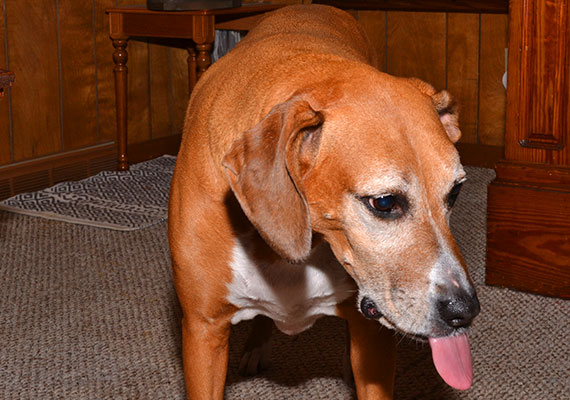
She wouldn’t give these another lick.
So, we set out to assemble the largest testing team ever assembled for a DogLab review!
After our team called in favors from every dog owner they knew and approached strangers at local dog parks, we rounded up a huuuuge range of dogs.
Our team of puppy testers included a wide range of power chewers, including a German Shepherd, Jack Russell Terrier, Pit Bull, and Beagle, just to name a few.
All up, well over 100 dogs took part in our anti-chew spray review.
Every anti-chew spray featured in this guide was tested by at least 50 different dogs. This way, we could find the anti-chew sprays that deterred the widest range of dogs possible.
The following two factors weighed heavily when choosing our top picks:
1. How many dogs were deterred by the anti-chew spray?

Out of the 50+ dogs that licked and sniffed the anti-chew spray, how many were deterred by it? This was done by using a rubber ball and offering it to the dog. We took the ball away and sprayed it with an anti-chew spray. We then offered it again to our tester. If he accepted the ball, the anti-chew spray failed for that dog.
2. Does the anti-chew spray leave a stain?

We applied each anti-chew spray to a power cord, piece of painted drywall, sealed piece of wood, and cotton sheet. We then cleaned each surface with ordinary household cleaners. In the case of the sheet, it went through a wash cycle. Any anti-chew spray that could not be easily removed, discolored or stained failed.
We considered the following during testing…
- Was the anti-chew bottle easy to spray?
- Did the spray nozzle clog during testing?
- Was the anti-chew spray scented?
- Could the anti-chew spray be applied directly to a dog?
- Did the anti-chew spray contain ingredients that are dangerous to dogs?
Testing observations
While testing each anti-chew spray for the above qualities, we made some observations that are worth mentioning…
1. Watch those ingredients

I know, I know… If you have chosen a good anti-chew spray, then your dog shouldn’t be licking or biting it at all.
But for your dog to determine he doesn’t like the spray, he’s very likely going to lick it.
Now here’s the problem: There are some things that you don’t want near your dog’s mouth.
For example, isopropanol (rubbing alcohol) was found in some of the anti-chew sprays we tested. Isopropanol is considered toxic to dogs, even in small amounts,[6] and is probably something you want to avoid giving your dog in large quantities.
Tea tree oil is a little more complicated. This commonly used anti-chew spray ingredient is considered non-toxic in concentrations less than 1-2%. Anti-Chew spray brands keep the tea tree below this amount.
Inspect the ingredients of any anti-chew spray you buy, especially if your dog has allergies.
2. You can apply anti-chew sprays directly to your dog

During our review, we came across many owners who used an anti-chew spray to stop their pups from chewing on injuries.
Grunt, a snuffly Bulldog, recently had surgery to remove a foxtail that was deeply embedded in his leg. His owner used an anti-chew spray to stop him from biting his stitches.
Another owner used an anti-chew spray to stop a Golden Retriever from licking at an itchy hotspot.
When used on injuries, an anti-chew spray can be a great alternative to the cone of shame.
3. Dog sprays might not stop a determined dog
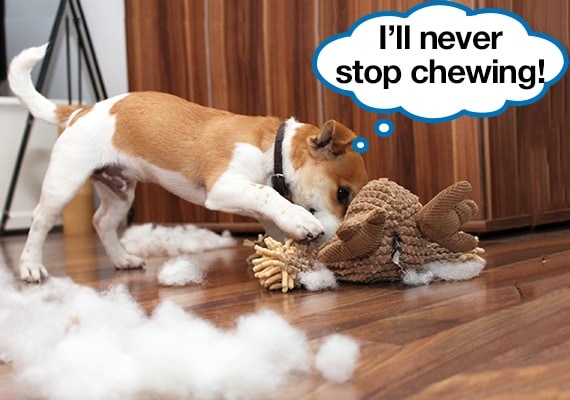
Pepper is a Dalmatian that looooooves to play. She might just be the most toy-obsessed dog I have ever met. She loves to play so much that she ignored every anti-chew spray we used with her. She could obviously taste it because she sneered as she picked up the balls, but her desire to play overcame the bitter flavors and foul scents.
Interestingly, Pepper also has a fleece blanket that she will happily chew the corners of. When we sprayed this with an anti-chew spray, she gave the blanket a small nibble before reeling in disgust. She didn’t pick it up again until we washed it. I suspect this is because she is not as obsessed with her blanket as she is with her toys.
Fortunately for Pepper, she is allowed and encouraged to chew on her dog toys. But it did go to show that an anti-chew spray may not stop a super-determined dog from chewing.
It is for this reason that an anti-chew toy should be used as a training aid. The one-two punch of an anti-chew spray and dog training will stop your pup’s destructive behavior for good.
4. Many anti-chew sprays smell

Anti-chew sprays come in a wide range of scents. Some are basically odorless while others give off a strong odor. While many were pleasantly scented, some had a strong medicine-like smell.
Fortunately, for most sprays, this was only noticeable when you held the spray up to your nose.
This won’t be a problem if you spray your baseboards or chair legs. Unless you get down on all fours or have a super-sensitive nose, you won’t be able to smell these areas.
But things can get a little problematic when spraying pillows and blankets. These household items sit closer to your nose. I discovered this when testing the anti-chew sprays on throw pillows at my mother’s house. Let me tell you… Some sprays stink!
I’ll do my best at describing the scent of each anti-chew spray when I reveal my top picks.
5. How long an anti-chew spray lasts depends on your dog

One of the factors we wanted to test when ranking anti-chew sprays was how long they lasted. After all, it doesn’t matter how well an anti-chew spray works if you need to reapply it every hour to deter your dog.
Unfortunately, testing this quality proved to be harder than we anticipated. Some dogs stayed clear for a day or two but others only for a few hours – even among the same breed.
As a result, we decided to scrap these results because they proved to be inconclusive.
Okay, now it’s time to share the best and most effective anti-chew sprays available…
Best Anti-Chew Sprays
Have you decided to give an anti-chew spray a shot? Here are 15 different anti-chew sprays, ranked from best to worst, based on our test results.
| Size | 8 fl oz |
| Staining | No |
| Scent | Tea tree |
When it came to anti-chew sprays, there was one clear winner. 9/10 dogs outright rejected anything we coated with the Rocco & Roxie Extreme Bitter Spray.
There is a lot to love about this anti-chew spray. It doesn’t stain, and the scent is pleasant. Best of all, this anti-chew spray is alcohol-free. It won’t sting if you spray it directly on your dog.
If you are looking for an anti-chew spray to stop your destructive dog, this should be your starting point. There is a good chance it’s the last anti-chew spray you will ever need.
| Sizes | 4, 8 and 16 fl oz |
| Staining | No |
| Scent | Mild citrus |
Coming in second place is the Fooey! Ultra-Bitter Training Spray. Another strong performer, 8/10 dogs were disgusted by this chew deterrent.
This is one of the few anti-chew sprays that is available in multiple sizes. For those who need a lot of anti-chew spray, the 16-ounce bottle is twice the size of most of the other anti-chew sprays we tested.
What the small-sized Fooey! Ultra-Bitter spray lacks in size, it makes up for in portability. It easily fit at the bottom of my handbag, without leaking. Pull it out when your dog starts being destructive away from home, such as in the car.
| Size | 8 fl oz |
| Staining | No |
| Scent | Lemon/Tea tree |
Emmy’s Best spray is another strong performer. Interestingly, Emmy’s Best also includes a training program, which they guarantee to eliminate chewing in just 14 days.
This was also one of the only anti-chew sprays we reviewed to offer a money-back guarantee. Their website states that if it doesn’t work, you can send it back for a full refund – even if the bottle is empty.
Be mindful that this anti-chew spray contains isopropanol (rubbing alcohol). If you spray it on an open wound, it will sting.
| Size | 8 or 16 fl oz |
| Staining | Yes |
| Scent | Rubbing alcohol |
I don’t think there has been an anti-chew spray on the market longer than Grannick’s Bitter Apple Spray. I’m pretty sure this is the same spray my mom bought back in the 90s for our Dachshund who loved to chew on the curtains. It’s been a long time, but I don’t think the bottle has changed one bit!
Interestingly, this was the only anti-chew spray to fail our stain test. We sprayed this on a white cotton sheet and left it to dry before putting it through a wash cycle. An obvious off-white stain remained.
It is for this reason that we do not recommend Grannick’s Bitter Apple Spray for fabrics like curtains, pillows and couches.
I was kind of disappointed that Grannick’s Bitter Apple didn’t smell anything like apples. Instead, it smells strongly of rubbing alcohol, largely due to isopropanol being a major ingredient. We advised above that isopropanol is something to avoid, so we recommend going with a more natural product without it or making sure your dog doesn’t ingest much of this product at a time.
Grannick’s Bitter Apple worked best when applied to hard surfaces. It doesn’t leave a sticky residue and can easily be removed with a damp cloth.
| Size | 8 fl oz |
| Staining | No |
| Scent | Bitter scent |
The Pets Are Kids Too no-chew spray performed quite well. However, the bottle is terrible. The wrapper on all the bottles we tested slid around as we sprayed, making the bottle difficult to grip.
There were other problems with the bottles as well. The nozzle on one of our sprays dripped during each spray, covering our hands. Another leaked when it was laid on its side.
| Size | 8 fl oz |
| Staining | No |
| Scent | Tea tree |
Another strong performer, the Fur Goodness Sake Bitter Apple Spray, was previously sold under the OmegaPet brand. Don’t worry if you get a bottle branded with OmegaPet. It’s the same thing.
This was the only anti-chew spray we reviewed that listed denatonium benzoate as the bittering agent, commonly called Bitrex. This is one of the most bitter synthetic chemicals available. It’s non-toxic and commonly used to coat small objects that kids might otherwise swallow. Nintendo game cartridges are coated in this.[7]
| Size | 32 fl oz |
| Staining | No |
| Scent | Cherry |
My biggest gripe with anti-chew sprays is that they come in these tiny bottles. If you apply the spray regularly, you’ll soon run out.
That’s why I was rooting for Out! Bitter Cherry Chew Deterrent to place first. At 32 fluid ounces, this is one of the most generous anti-chew sprays on the market and at a reasonable price too.
Unfortunately, it came down to a coin flip as to whether dogs would be deterred by the spray or not. Almost 50% of our testers happily licked this spray without a reaction.
Interestingly, we found this anti-chew spray attracted many of our dogs to whatever object we sprayed it on. This is possible because of the strong, pleasant cherry smell it gives off. Many of our dogs stopped what they were doing and came over to investigate the source of the scent.
While this makes it the nicest smelling anti-chew spray we reviewed, you don’t want your pup attracted to the object you want him to stop chewing – especially if he is one of the dogs that isn’t deterred by this no-chew spray.
| Size | 8 fl oz |
| Staining | No |
| Scent | Cherry |
Guess what? This anti-chew spray has the same formula as the previous one. This is because both Vet’s Best and Out! are owned by the same company – they simply reused the recipe.
As you might expect, the performance was identical. The only difference is that Vet’s Best Bitter Cherry Spray comes in a bottle that is four times smaller – and it costs more to boot!
Pay more, get less? Buy the Out! Bitter Cherry Chew Deterrent instead.
| Size | 4, 8 and 17 fl oz |
| Staining | No |
| Scent | Alcohol |
This is another anti-chew spray available in multiple sizes. Bodhi Dog Bitter Lemon Spray also offers a money-back guarantee if you are unsatisfied with their anti-chew spray. We advised above that isopropanol is something to avoid, so we recommend going with a more natural product without it or making sure your dog doesn’t ingest much of this product at a time.
| Size | 8 fl oz |
| Staining | No |
| Scent | Tea tree |
Interestingly, the Particular Paws Anti-Chew Bitter Spray had the same ingredients as Emmy’s Best, the third placing anti-chew spray. However, there might be a difference in the formula as dogs were considerably more likely to chew something coated in this anti-chew spray.
| Size | 8 or 16 fl oz |
| Staining | No |
| Scent | Tea tree |
Okay, so this one came as a shock. Nature’s Miracle No-Chew Deterrent Spray was the worst-performing anti-chew spray by a long shot. The results from our testing were so poor that we went out and purchased another batch from a different supplier, just in case the bottle was a dud.
Nope. The results were the same. For some reason, very few dogs were deterred by this anti-chew spray.
We suspect the poor performance came down to the ingredients used. While most other anti-chew sprays contain similar ingredients, Nature’s Miracle decided to use an unusual mix of plant extracts.
| Size | 8 or 16 fl oz |
| Staining | No |
| Scent | Tea tree |
You might have noticed that I didn’t list Natural Rapport Dog Repellent Spray’s success rate. Well, we had a little trouble. When freshly applied, it was more than capable of deterring a chewer.
However, when it dried, it didn’t appear to have any effect. The problem is that it dries quickly. In the heat, it took less than 10 minutes for the spray to dry completely. At this point, our dogs happily put their mouths on whatever it was sprayed on.
The Natural Rapport Dog Repellent Spray works but not for long enough.
What about the DIY options?
I also tested 3 homemade chewing deterrent recipes:
- 2 parts lemon juice to 1 part white vinegar – 22% success rate
- 2 parts apple cider vinegar to 1 part white vinegar – 32% success rate
- 1 part cayenne to 10 parts water – 50% success rate
Interestingly, all of these DIY recipes worked to some degree. However, that was when they were freshly applied. Repeating the test after the spray dried saw a significantly lower success rate. The only recipe that was still effective after drying was the one with cayenne. However, it had a tendency to stain.
Overall, the homemade recipes failed to impress. If you are determined to go down this route, my personal recommendation would be the apple cider vinegar – white vinegar combination.
Conclusion
Phew, if you made it this far, congratulations! You now know which anti-chew spray is best for your dog.
A recap of our results…
The top 5 best anti-chew sprays we reviewed:
- Rocco & Roxie Extreme Bitter Spray – 90% Effective
- Fooey! Ultra-Bitter Training Spray – 80% Effective
- Emmy’s Best – 78% Effective
- Grannick’s Bitter Apple Spray – 76% Effective
- Pets Are Kids Too Bitter Spray – 70% Effective
Which anti-chew spray stopped your dog from unwanted chewing? Let me know in the comments below!
Tagged With: clean, home











